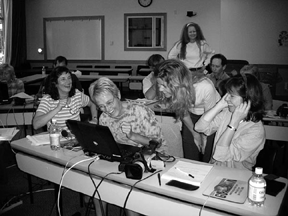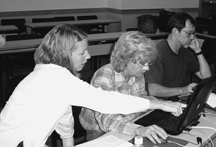
|
| Volume 49, Number 3, Fall 2000 |
REPORTERS TRADE NOTEBOOK FOR A VIDEO CAMERAby Jane Ellen Stevens We're in the midst of a communications transformation that's as mind-altering and world-changing as Gutenberg's printing press was. The Internet and the World Wide Web are transforming the way people obtain their news of the day, no matter what type of news it is. All too soon, news organizations and organizations that provide news and information about their activities will focus most of their efforts on telling their stories on the Web instead of in print or on television. To tell effective stories in this medium, modern storytellers must understand its new language. They must be able to decide what information to deliver in text, video, still photos, graphics, or animation. Then, they must wrap up the whole story in an interactive matrix. Today on the Web, most of the multimedia stories you see are organized and produced by an editor or producer who obtains video, still photos, text, graphics, and animation from different people. In this context, writers are still writers-they provide only the text for a story. This is a great approach for breaking news and for some types of features. But for in-depth, feature, and investigative stories-stories that traditionally live in the head of the reporter and see the light of day with the guidance of an editor-the producer-driven model doesn't work as well. In the multimedia world, reporters who want to tell their stories effectively must develop another set of skills. To tell effective stories in this medium, modern storytelers must understand its new language. Every news organization should be training one or two reporters or public information officers in multimedia reporting. They need to trade their reporter's notebook for a digital video camera. They need to know how to think visually for every story that they produce, and abandon words when graphics or video or still photos work better. Organizations that provide news and information (scientific institutions, museums, universities, etc.) aren't exempt. The Web allows them to communicate more directly with and develop their own publics instead of relying as heavily on the news media to get their stories out. Instead of writing press releases, this new approach requires that they tell stories as journalists do. Of course, not every story requires video AND stills AND graphics AND animation AND text. But storytellers equipped with the entire skill-set can make the best decision about which elements to include, given the constraints of time, resources, and money. Modern storytellers don't necessarily have to know how to produce graphics, but they should know what information would work best in graphics and work with a computer-graphics expert. For three days in August, the Northern California Science Writers Association (NCSWA) presented the first (that we know of) multimedia-reporting workshop for science and technology journalists, at the Lawrence Berkeley National Laboratory, in Berkeley, CA. This intense workshop was designed for experienced journalists and public information officers who wanted hands-on experience in multimedia reporting. Nine participants received a thorough introduction to the new language of multimedia storytelling. They transformed a plain text story into a multimedia story containing text, still photos, video clips, graphics, and interactivity. Workshop instructors pushed participants into the new world of multimedia storytelling. As a multimedia journalist and workshop organizer, I reviewed the basics of multimedia storytelling on the Web and demonstrated the types of approaches that succeed at making the best use of the Web's characteristics. Joe Lambert, co-director of the Center for Digital Storytelling, in Berkeley, CA., provided insight into another critical characteristic of the Web: the intimate nature of storytelling in this medium, and how those who tell stories can, and in some instances must include their own voice in their story. The rest of the workshop was nuts, bolts, sweat, and deadlines. Lambert and his assistants provided tutorials in how to use a digital video camera and how to edit video using Adobe Premiere. Lawrence Berkeley Lab Webmaster Jeff Kahn (one of the workshop participants), LBL science writer Annette Greiner, and I worked in advance the workshop to develop story assignments. Participants worked in groups of three to shoot their video and interview researchers, put together a story, and upload it to a Web page. Mentors Mary Miller, a multimedia journalist who produces stories and projects for the Exploratorium's web site, and Lisa Strong-Aufhauser, a freelance journalist who came to multimedia from the documentary world, assisted the participants in shooting, editing, and figuring out how to tell their stories. At the end, participants were weary and nearly brain-dead, but all said the workshop was worth the $500 entrance fee. Future workshops will be more expensive-the fee did not reflect the costs that went into producing it, since the workshop was partly an experiment. Everyone agreed that five days were needed for the amount of information that needs to be learned. The Monterey Bay Aquarium is already scheduling a similar workshop for its public relations staff and its aquarists who have stories to tell about their work. n Jane Stevens is a freelance multimedia journalist who lives in Northern California. E-mail her at jstevens@mmjourno.com. Participants' reaction, in their own words.Intense and inspiring! My enthusiasm for the benefits of this new medium has spread throughout the public relations department at the Monterey Bay Aquarium. So much so that producing our own multimedia stories is now part of the department's future goals as we move toward "paperless" public relations. Karen Jeffries
Diane Ainsworth I have long wanted to explore the use of multimedia in daily reporting but have had no experience with the tools and techniques. The course exposed me to the principles of audio-visual storytelling; the use of video cameras; the editing of video, audio, and still images; and the creation of a Web page that contained a short movie clip. It was a great experience, but I think the course needed to be two days longer. Web design got scant attention, and we did not get a chance to manipulate still images in Photoshop. Tom Abate
Robert Sanders A television background conditioned me to think anything with lots of text was just too flat (two-dimensional) to be interesting-no sound, no moving pictures . . . Just as it's necessary to figure out what really works on TV, it's necessary to figure out what really works on a Web site . . .if you want to attract and keep users. I enjoyed sharing information and the comfort of being with a group of other professionals who are just as inexperienced in thinking in an interactive format as I am. I now have some confidence in continuing down that path, developing my skills on the job and challenging the use of pure TV on Internet. Bailey Barash |

